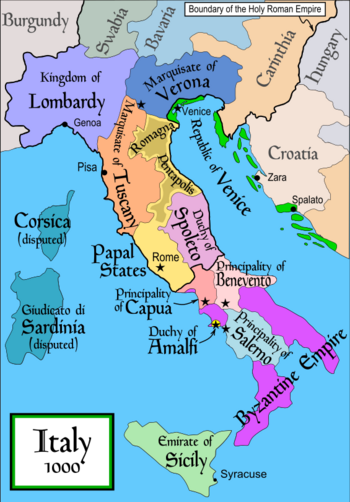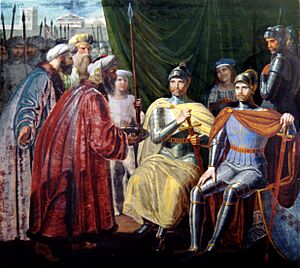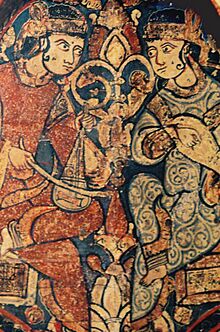Muslim Sicily facts for kids
Quick facts for kids
Muslim Sicily
صِقِلِّيَة (Arabic)
|
|||||||||
|---|---|---|---|---|---|---|---|---|---|
| 831–1091 | |||||||||

Italy in 1000. The Emirate of Sicily is in light green.
|
|||||||||
| Status |
|
||||||||
| Capital | Palermo | ||||||||
| Common languages | Sicilian Arabic, Byzantine Greek, Berber languages, Judeo-Arabic | ||||||||
| Religion |
|
||||||||
| Government | Monarchy | ||||||||
| Historical era | Middle Ages | ||||||||
|
• Established
|
831 | ||||||||
|
• Disestablished
|
1091 | ||||||||
| Currency | Tarì, dirham | ||||||||
|
|||||||||
| Today part of | Italy Malta |
||||||||
The island of Sicily was ruled by Muslims from the late 800s to the late 1000s. It became a rich and important trading power in the Mediterranean. Its capital, Palermo, was a big cultural and political hub for the Muslim world.
Before Muslim rule, Sicily was part of the Byzantine Empire. Muslim forces from Ifriqiya (which is roughly modern-day Tunisia) started raiding Sicily in 652. A long series of battles from 827 to 902 led to the gradual Muslim conquest of the island. Only the fortress of Rometta held out until 965.
After 909, the Fatimid Caliphate took over from the Aghlabids. From 948 onwards, the island was governed by the Kalbid dynasty. They ruled as independent leaders (called emirs) but still recognized the Fatimids as their main authority.
Under Muslim rule, Sicily became a place where many different religions and languages existed side-by-side. A unique culture developed, mixing Islamic Arab and Berber traditions with local Latin, Greek, and Jewish ways. New and valuable crops were brought in, and advanced irrigation systems were built. Cities were made more beautiful with gardens and public buildings. This wealth helped art and science to flourish.
In the early 1000s, political power started to break apart due to internal fights. Christian Norman fighters, led by Roger I, eventually conquered the island. They founded the County of Sicily in 1071. The last Muslim city on the island, Noto, fell in 1091. This marked the end of independent Muslim rule in Sicily.
Roger I, the first Count of Sicily, allowed a good amount of tolerance and multiculturalism. Sicilian Muslims remained citizens and even held positions in the royal court until the late 1100s. Until the 1220s, Muslims likely made up most of the island's population. However, by the mid-1200s, Muslims who had not left or converted to Christianity were forced to leave. This ended about 400 years of Islamic presence in Sicily.
More than two centuries of Muslim rule left some lasting marks on modern Sicily. There's a small Arabic influence in the Sicilian language and in local place names. A much bigger influence is seen in the Maltese language, which comes from Siculo-Arabic. Other cultural traces can be found in the island's farming methods, crops, food, and architecture.
Contents
A Look at History
Early Attacks on Sicily
In 535, Emperor Justinian I brought Sicily back under the control of the Roman Empire. At this time, the Roman Empire was ruled from Constantinople and is now known as the Byzantine Empire. As the Byzantine Empire's power in the West grew weaker, a new power was rising in the Middle East: the Rashidun Caliphate. This was the first major Muslim state after the death of the Islamic prophet Muhammad in 632.
Over 25 years, the caliphate took over much of the Persian Sasanian Empire and former Roman lands in the Middle East and North Africa. In 652, under Caliph Uthman, an invasion captured most of Sicily. However, Muslim control was short-lived, and they left after his death.
By the end of the 600s, Muslims had captured the nearby port city of Carthage. This allowed them to build shipyards and a permanent base for more attacks. Around 700, the island of Pantelleria was captured by the Umayyads. Disagreements among the Muslims stopped an invasion of Sicily at that time. Instead, they made trade agreements with the Byzantines, allowing Muslim merchants to trade at Sicilian ports.
The first real attempt to conquer Sicily happened in 740. In that year, the Muslim prince Habib successfully captured Syracuse. They were ready to conquer the whole island but had to return to Tunisia because of a Berber revolt. A second attack in 752 only aimed to raid Syracuse again.
The Muslim Conquest
In 826, Euphemius, a commander in the Byzantine navy in Sicily, forced a nun to marry him. Emperor Michael II found out and ordered that Euphemius be punished. Euphemius rebelled, killed a general, and took over Syracuse. He was later defeated and fled to North Africa.
He offered to give control of Sicily to Ziyadat Allah, the Aghlabid emir of Ifriqiya (present-day Tunisia). In return, Euphemius wanted to be a general and be safe. The Emir agreed, promising Euphemius the island for a yearly payment. The conquest was given to Asad ibn al-Furat, a 70-year-old judge (qadi). He led 10,000 foot soldiers, 700 horsemen, and 100 ships.
With Muslim help, Euphemius's ships landed at Mazara del Vallo. The first battle against Byzantine troops happened on July 15, 827, and the Aghlabids won. Asad then conquered the southern coast of the island and began a siege of Syracuse. After a year-long siege, his troops defeated a large army sent from Palermo. A plague then killed many Muslim soldiers, including Asad himself. This forced the Muslims to retreat. They later attacked again but failed to conquer Castrogiovanni, where Euphemius was killed.
In 830, the remaining Muslims in Sicily received strong reinforcements of 30,000 troops from Ifriqiya and Andalusia. These Iberian Muslims defeated the Byzantine commander Teodotus. However, another plague forced them to return. Later, Ifriqiyan units besieged Palermo, the Sicilian capital. They captured it in September 831 after a year-long siege. Palermo became the Muslim capital of Sicily, renamed al-Madinah ("The City"). It served as a base for further conquests.
The conquest was a slow, back-and-forth process. With much resistance and internal struggles, it took over a century to fully conquer Byzantine Sicily. Messina was captured in 842 or 843. It became a base for campaigns into the Italian mainland. Syracuse was captured in 878. The island was not fully conquered until 902, when Taormina was taken. Even after this, some Christian resistance continued until 967.
Muslim Rule in Sicily
Sicily was first ruled by the Sunni Aghlabid dynasty in Ifriqiya until 909. Then, the Shiite Fatimids took over. The first years of Fatimid rule were difficult. Sicilian Muslims had started to develop their own identity and resisted new rulers. The first Fatimid governor was kicked out in 912.
In 948, the Fatimid caliph al-Mansur appointed al-Hasan ibn Ali al-Kalbi as governor. He became the first emir of the Kalbid dynasty. This family effectively ruled Sicily for the next century on behalf of the Fatimids. Under Ahmad, al-Hasan's son, Taormina was conquered again in 962. Rometta was conquered soon after.
The Fatimids later moved their capital to Egypt in 972–973. They left the Zirids as their representatives in Ifriqiya. After this move, the Fatimid caliphs recognized the Kalbids as hereditary rulers. The Kalbids then governed the island as amirs for them.
During this time, Sunni Muslims were the majority of the Muslim community in Sicily. Most people in Palermo were Sunni, which led to some tension with the Shia Kalbids. The Sunni population grew with refugees from North Africa. These refugees were fleeing harsh religious policies by the Fatimids. The Byzantines took advantage of these internal conflicts to briefly occupy the eastern part of the island.
Raids into Southern Italy continued under the Kalbids into the 1000s. In 982, a German army under Otto II, Holy Roman Emperor was defeated near Crotone. Under Emir Yusuf al-Kalbi (986–998), a period of decline began. Internal family conflicts grew worse under al-Akhal (1017–1037). Different parts of the ruling family allied with the Byzantine Empire and the Zirids.
Decline and Norman Conquest

By the 11th century, southern Italian powers hired Norman fighters. These Normans were Christian descendants of the Vikings. It was the Normans, led by Roger de Hauteville (who became Roger I of Sicily), who took Sicily from the Muslims. In 1038, a Byzantine army, including Normans, crossed into Sicily. After a big victory in 1040, the Byzantine general was removed. Muslim forces then recaptured all the cities the Byzantines had taken.
The Norman Robert Guiscard began conquering Sicily in 1060. His brother Roger de Hauteville took Messina with 700 knights. The Muslim rule in Sicily began to break apart due to internal family quarrels. By 1044, the island was split into four small areas, each ruled by a local leader. These leaders often fought among themselves for power.
One leader, Ibn Thumna, worked closely with the Normans. Both sides used the other to try and gain control of the entire island. Even after Ibn Thumna's death, his allies continued to work with the Normans. Muslim troops even made up most of the Norman army in Sicily.
The Zirids of North Africa sent an army to Sicily. These troops slowly brought the divided areas under their control. However, they lost two major battles against the Normans. The Sicilians and North Africans were defeated in 1063 at the Battle of Cerami. This secured Norman control over the northeast of the island. The large Christian population also rose up against the Muslim rulers.
In 1068, Roger and his men defeated the Zirid army at the Battle of Misilmeri. The Zirids returned to North Africa, leaving Sicily in chaos. Catania fell to the Normans in 1071. Palermo, the capital, fell on January 10, 1072, after a five-month siege. Trapani surrendered the same year.
Losing the main port cities greatly weakened Muslim power. The last area of strong resistance was Syracuse, led by Ibn Abbad. He defeated Roger of Sicily's son in 1075 and briefly reoccupied Catania. However, Roger besieged Syracuse in 1086. Ibn Abbad died trying to break the siege in a naval battle. Syracuse surrendered after this.
In 1091, Butera and Noto in southern Sicily, and the island of Malta, easily fell to the Christians. After conquering Sicily, the Normans removed the local Muslim leader. However, they respected the customs of the Arab people living there.
Life in Muslim Sicily
The new Arab rulers started land reforms. These changes helped farms produce more and encouraged smaller landholdings. The Arabs also improved irrigation systems using Qanats (underground water channels). They brought in new and valuable crops like oranges, lemons, pistachios, and sugarcane.
A merchant from Baghdad, Ibn Hawqal, visited Sicily in 950. He described Palermo. A walled area called the Kasr (the palace) is still the center of Palermo today. The main mosque was on the site of the later Roman cathedral. Another area, Al-Khalisa (Kalsa), had the Sultan's palace, baths, a mosque, government offices, and a private prison. Ibn Hawqal said there were 7,000 butchers in 150 shops.
The exact population of Palermo during this time is unclear. Some historians estimate it was around 60,000, while others suggest it could have been over 100,000.
The traveler and poet Ibn Jubair visited in the late 1100s. He described Palermo as a city of "splendor and wealth." He noted its wide streets, beautiful location, and many mosques that also served as schools.
During Muslim rule, there were sometimes revolts by Byzantine Christians, especially in the east. Some lands were even re-occupied before the revolts were put down.
The local people conquered by the Muslims were mostly Greek-speaking and Latin-speaking Byzantine Christians. There were also many Jews. Christians and Jews were allowed to practice their religions under Muslim rule. They were called dhimmis. However, they had to pay a special tax called jizya (head tax) and a land tax called kharaj. Muslims, however, paid a different tax (Zakaat).
About half the population was Muslim at the time of the Norman Conquest. The peaceful coexistence with the conquered people changed after the Normans started reconquering Sicily in the 1160s. This was especially true after the death of King William II of Sicily in 1189. Muslims then faced similar harsh treatment that Christians had faced earlier.
How Sicily Was Governed
The emir, who lived in what is now the Royal Palace in Palermo, held most of the power. He controlled the army, government, justice system, and money. He appointed governors for major cities, important judges (qāḍī), and people to settle small disputes (hakam). There was also a group of important people called giamà'a. They gave advice and sometimes made big decisions when the emir was not available.
It is also likely that the government had a special workshop called a tiraz. This workshop made valuable fabrics like silk. These fabrics were given as gifts to important people or foreign visitors.
Muslim rule was not always the same across the island. Sicily was divided into three main areas, each governed differently. Western Sicily had more Muslims and was directly controlled. The northeast region, Val Demone, remained mostly Christian and often resisted Muslim rule. In this area, the focus was more on collecting taxes and keeping order.
The soldiers who conquered the lands received four-fifths of the spoils. One-fifth was kept by the state or the local governor, following Islamic law. This rule was not always followed, but it did lead to the breakup of large estates. This allowed for better use of the land. New crops were introduced, such as sugarcane, vegetables, citrus fruits, dates, and mulberry trees. Mining also began.
Coins Used
The Arabs introduced new coins. The dinar was a gold coin weighing 4.25 grams. The dirhem was a silver coin weighing 2.97 grams. The Aghlabids also used the solidus in gold and the follis in copper. After Palermo was conquered in 886, a coin called the kharruba was made, which was worth 1/6 of a dirhem.
What Happened Next

The Norman Kingdom of Sicily under Roger II was known for being "multi-ethnic and religiously tolerant." Normans, Jews, Muslim Arabs, Byzantine Greeks, Lombards, and native Sicilians lived together fairly peacefully. Arabic remained a language of government for at least 100 years under Norman rule. Traces of Arabic can still be found in the Sicilian language and even more in the Maltese language today.
Muslims also continued to be important in industries like manufacturing, retail, and production. Muslim craftsmanship, building skills, and knowledge in government were highly valued.
However, Muslims on the island eventually had to choose between leaving or living under Christian rule. Many Muslims chose to leave if they could afford it. Muslims also slowly converted to Christianity. The Normans replaced Orthodox Christian leaders with Latin Christian ones. Some Muslims pretended to convert, but this only helped individuals, not the whole community.
Attacks against Muslims by people from Lombardy began in the 1160s. Muslim and Christian communities in Sicily became more separated by geography. Even though Muslims were likely still the majority, their communities became isolated. They were mainly in the south and west of the island, while the north and east remained Christian. As a conquered people, Sicilian Muslims depended on the kindness of their Christian rulers and the king's protection.
After King William the Good died in 1189, royal protection was removed. This opened the door for widespread attacks against Muslims. This ended any hope of peaceful coexistence. The deaths of Henry VI and his wife Constance a year later caused political chaos in Sicily. With no royal protection, and Frederick II still a child, Sicily became a battleground.
Muslim rebels on the island sided with German warlords. In response, Pope Innocent III declared a crusade against one warlord, claiming he had allied with the "Saracens" (Muslims) of Sicily. By this time, the Muslim rebellion was in full swing. They controlled several towns in western Sicily. The rebels were led by Muhammad Ibn Abbād, who called himself the "prince of believers" and even minted his own coins.
However, Frederick II, now an adult, launched campaigns against the Muslim rebels in 1221. His forces defeated the defenders of the fortresses. Instead of killing the Muslims, who numbered about 60,000, Frederick II began moving them to Lucera in Apulia in 1223. The next year, expeditions were sent to Malta and Djerba to gain royal control and stop their Muslim populations from helping the rebels. Interestingly, Muslim archers remained a common part of these "Christian" armies.
The House of Hohenstaufen and later rulers gradually made Sicily more "Latin" (Catholic) over two centuries. This process helped introduce Latin Catholicism instead of Byzantine Christianity. The Roman Church and its practices largely supported this change. The removal of Islam from Sicily was completed by the late 1240s, when the last deportations to Lucera happened. By the time of the Sicilian Vespers in 1282, there were no Muslims left in Sicily, and the society was completely Latinized.
Leaders of Muslim Sicily
Kalbids
- al-Hasan al-Kalbi (948–953)
- Ahmad ibn al-Hasan al-Kalbi (954–969)
- Ya'ish (969–970), a ruler who took power illegally
- Abu'l-Qasim Ali ibn al-Hasan al-Kalbi (970–982)
- Jabir al-Kalbi (982–983)
- Ja'far al-Kalbi (983–985)
- Abdallah al-Kalbi (985–990)
- Yusuf al-Kalbi (990–998)
- Ja'far al-Kalbi (998–1019)
- al-Akhal (1019–1037)
- Abdallah (1037–1040), a Zirid ruler who took power illegally
- Hasan as-Samsam (1040–1053)
Leaders during the "Taifa" Period (Divided Rule)
- Abdallah ibn Mankut – Ruled Trapani and Mazara (1053–?)
- Ibn al-Maklatí – Ruled Catania (1053–?)
- Muhammed ibn Ibrahim (Ibn Thumna) – Ruled Syracuse (1053–1062) and later Catania and Trapani/Mazara
- Alí ibn Nima (Ibn al-Hawwàs) – Ruled Agrigento and Castrogiovanni (1053–about 1065), and all Taifas from 1062
- Ayyub ibn Tamim (Zirid) (about 1065–1068)
- Ibn al-Ba'ba, Ruled Palermo (1068–1072)
- Hammad – Ruled Agrigento and Castrogiovanni (1068–1087)
- Ibn Abbad (Benavert) – Ruled Syracuse and Catania (1071–1086)
Images for kids
See also
- Emirate of Bari
- History of Islam in southern Italy
- History of Sicily
Sources






